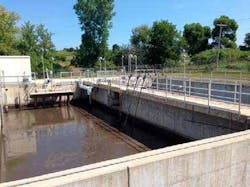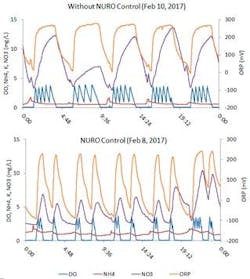Do More with Less: Integrating Nutrient Removal Control Improves Treatment Capacity and Efficiency
Wastewater treatment plants (WWTP) are facing many challenges. Permits on nitrogen and phosphorus in the effluent water are progressively becoming stricter in order to protect surface waters from eutrophication. At the same time, plants are required to reduce both energy and chemical consumption and are often challenged with limited time and staff. In total, they are required to do more with less.
In order to meet these challenges, a plant with a Sequencing Batch Reactor (SBR) in Green Lake, Wisconsin was upgraded with an advanced process control system – the OSCAR process performance optimizer with NURO controller. By controlling the process in a smarter way, the plant experienced improved total nitrogen removal while reducing energy consumption and wear on the blower. In addition, the controller adjusted the process for optimized biological phosphorus removal, resulting in effluent total phosphorus concentrations consistently below 1 mg/l with minimal to no chemical addition.
Plant data
The study was conducted at the WWTP serving the city of Green Lake, Wisconsin. The plant has a continuous feed ICEAS advanced SBR, operated for ammonia and phosphorus removal with a treatment cycle consisting of anaerobic followed by aerobic conditions. No designed anoxic treatment cycles were included.
During the study, the influent and effluent streams to the ICEAS system were monitored with 24 hour composite samples analyzed for organic material, nutrients and suspended solids. Online measurements of ammonia, nitrate, total suspended solids, orthophosphate and dissolved oxygen (DO) concentration were gathered from the ICEAS system basin. The SRT and MLSS of the process as well as the energy consumed by the blowers was monitored.
The operating temperature during the study was 7-8 °C in the winter and 15-20 °C in the summer.
Nutrient removal control system
Utilizing a combination of online sensor measurements and process knowledge, the NURO controller continuously adapted the process conditions in the basin to achieve an operator desired effluent ammonia concentration while optimizing total nitrogen and phosphorus treatment and minimizing energy consumption.
Result: Operational cost savings
The OSCAR system with NURO controller adjusted aeration of the process to the current requirement. Excess aeration during low loaded conditions wastes energy and also causes unstable control and wear on the blowers. By automatically detecting low loaded cycles, the NURO controller reduced energy consumption as well the number of blower starts. During summer operation, energy consumption was reduced by 22% and the number of blower starts by 50% compared to operating the basin without nutrient control. Chemical usage was also down during this time period by 55%. During the winter, energy savings of 10% was reached despite the process operating at 7°C.
Result: Improved treatment capacity
By automatically detecting lower loaded cycles and avoiding over-aeration, the NURO controller allowed time for anoxic treatment, which provided significant denitrification while still ensuring that the effluent ammonia concentration was maintained consistently below the desired setpoint. With the NURO controller, effluent NO2/NO3 of 1.2 mg/L and TN of 2.7 mg/l was achieved, despite the treatment cycle not being designed for total nitrogen removal.
The improved denitrification combined with the continuous influent carbon source also maximized anaerobic treatment and biological phosphorus removal. When first upgrading the plant with the NURO controller, only one basin was upgraded and compared to a parallel basin for reference. When operating the basins in parallel, the basin controlled with the NURO controller produced an average effluent TP of 0.86 mg/L, about 20% lower than the DO control basin which produced an average of 1.04 mg/L.
Conclusions
Both improved treatment capacity and reduced operation cost resulted from this plant upgrading their existing continuous flow ICEAS sytem and OSCAR system with the NURO controller. Despite being designed without anoxic treatment, the plant reached effluent TN of 2.7 mg/l while at the same time reducing energy consumption by up to 22%, blower starts by 50%, and chemical usage by 55%.
“The NURO controller reduced our aeration costs by 15% and helped optimized biological phosphorus removal and minimize chemical consumption.” – Glen McCarty, Wastewater Superintendent, Green Lake, Wisconsin.
Editor's Note: Scranton Gillette Communications and the SGC Water Group are not liable for the accuracy, efficacy and validity of the claims made in this piece. The views expressed in this content do not reflect the position of the editorial teams of Water & Wastes Digest, Water Quality Products and Storm Water Solutions.

